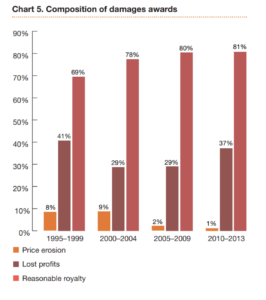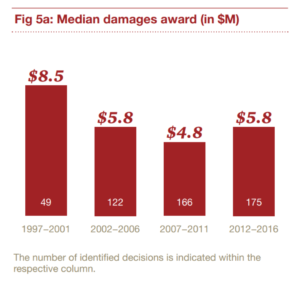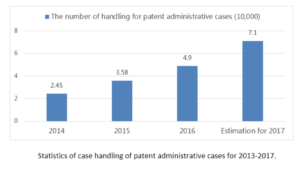Examining Differences Between Patent Laws in the US and China (Part 2)
Share
This article is the second of a two-part series by Eugene Liu. The first installment was published last week.
US and China Patent Law Enforcement (1): Different Compositions of Damages and Different Sums
China: the Court’s Discretion, Small Sums
Although Article 65 of China’s Patent Law establishes four successive criteria for determining the amount of damages to be awarded, nearly 97% of all patent disputes have their damages settled at the Court’s discretion. This is partly due to the difficulty of proving causation between the act of infringement and the losses suffered by the patentee. But because China’s Patent Law sets a limit of $1 million RMB for damages directly set by the Court, the average payouts for invention, utility model, and design patent infringement cases from 2013-2016 in China were a mere in $21,900 USD, $7,300 RMB, and $2,922 RMB respectively. These numbers are minuscule compared to the average damages awarded in patent dispute cases in the US.
US: Reasonable Royalties, Large Sums
Although Section 284 of US Patent Law establishes three successive criteria for determining damages, a study done by PriceWaterhouseCoopers (PWC) in 2014 on Patent Litigation in the US showed that from 1995-2013, an average of 77% of patent litigation cases had their damages determined by reasonable royalties—making it the preferred criteria in the US as opposed to the Court’s discretion in China.
 According to PWC, there are several reasons why US Courts prefer reasonable royalties as the criterion for determining damages:
According to PWC, there are several reasons why US Courts prefer reasonable royalties as the criterion for determining damages:
(1) Many entities that engage in patent litigation are non-practicing entities (NPE), meaning that they have registered patents but are not actively developing or commercializing the patent. For these NPEs, it would be hard to determine actual losses due to sales.
(2) Many entities are reluctant to disclose information regarding their lost profits or costs.
(3) Reasonable royalties are easier to determine compared to actual losses. Reasonable royalties do not require proof of causation, while actual losses do.
According to PWC, the median damages awarded in patent disputes from 2012-2016 was $5.8 million US dollars. This sum stands in stark contrast against the average damages of $32,357 US dollars awarded to patentees in China from 2013-2016.
 This huge disparity in damages awarded brings back the topic of compensatory and punitive damages. The purpose of punitive damages is not only to compensate for losses incurred by the patentee, but also to deter future offences of the same sort. The punitive damages system sacrifices proportionality but deters future violations; the compensatory damages system maintains proportionality but foregoes deterrence.
This huge disparity in damages awarded brings back the topic of compensatory and punitive damages. The purpose of punitive damages is not only to compensate for losses incurred by the patentee, but also to deter future offences of the same sort. The punitive damages system sacrifices proportionality but deters future violations; the compensatory damages system maintains proportionality but foregoes deterrence.
US and China Patent Law Enforcement (2): Administration and Judicature
China: Judicature Parallels Administration
The philosophy behind the enforcement of patent laws in China is that judicial protection and administrative power should complement and support each other. Article 60 of China’s current patent law gives patentees the option to take legal action before the courts or administrative action before state departments. The Fourth Amendment to China’s Patent Law bolsters administrative capabilities and, accordingly so, the number of patent dispute cases handled administratively has increased every year from 2014-2016.
 Administrative channels are faster and cheaper than judicial options. In the law firm I worked at over the summer, there was one case where our client was a food production company who possessed a design patent for the packaging of a particular product. The design patent was infringed and our client faced a choice between taking legal action before the courts, or petitioning an administrative authority. We advised that our client choose the latter due to three reasons: (1) the design patent was for a non-essential product, (2) the company’s time and resources were limited, (3) the product for which the design patent applied to was about to be sold to the general public. Our client brought the case before the State Intellectual Property Office and the dispute was resolved in 20 days.
Administrative channels are faster and cheaper than judicial options. In the law firm I worked at over the summer, there was one case where our client was a food production company who possessed a design patent for the packaging of a particular product. The design patent was infringed and our client faced a choice between taking legal action before the courts, or petitioning an administrative authority. We advised that our client choose the latter due to three reasons: (1) the design patent was for a non-essential product, (2) the company’s time and resources were limited, (3) the product for which the design patent applied to was about to be sold to the general public. Our client brought the case before the State Intellectual Property Office and the dispute was resolved in 20 days.
US: Judicature Takes the Main Stage
In the US, the majority of patent disputes are settled either through the courts or arbitrage. The two main administrative bodies that are involved with patents—the US Patent and Trademark Office (USPTO) and International Trade Commission (ITC)—are not actively involved in settling disputes. The USPTO is mainly responsible for filing patent and trademark applications, as well as providing useful resources for patentees. The ITC on the other hand is mainly concerned with patent protection and infringement in international trade.
It is the general consensus among US businesses that over-usage of administrative channels in patent disputes is undesirable. Patent disputes are complex and highly technical, and administrative apparatuses may not be prepared to handle the workload—resulting in murky decisions, opportunities for mismanagement, corruption, delays, and more disputes. The American perspective is that stronger judicial protection for patents is more preferable than a powerful administrative body.

Want to get involved?
Connect with us! Connect with us!